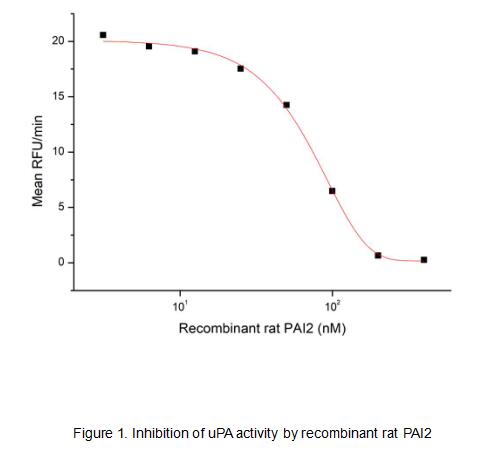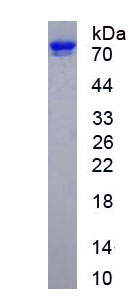Active Plasminogen Activator Inhibitor 2 (PAI2) 

SERPINB2; PLANH2; Serpin Peptidase Inhibitor Clade B Member 2; Monocyte Arg-serpin; Placental plasminogen activator inhibitor; Serpin B2; Urokinase inhibitor
- UOM
- FOB US$ 251.00 US$ 628.00 US$ 1,256.00 US$ 3,768.00 US$ 9,420.00
- Quantity
Overview
Properties
- Product No.APA531Ra61
- Organism SpeciesRattus norvegicus (Rat) Same name, Different species.
- ApplicationsCell culture; Activity Assays.
Research use only - DownloadInstruction Manual
- CategoryHematologyReproductive science
- Buffer FormulationPBS, pH7.4, containing 5% Trehalose.
- Traits Freeze-dried powder, Purity > 95%
- Isoelectric Point5.0
Sign into your account
Share a new citation as an author
Upload your experimental result
Review

Contact us
Please fill in the blank.
Activity test

Serpin B2, also known as PAI-2, is an approximately 60 kDa serine protease inhibitor. It is primarily secreted by macrophages and monocytes and can form disulfide-linked multimers. Serpin B2 inhibits both the urokinase-type and tissue-type plasminogen activators (uPA and tPA). Serpin B2 also promotes the clearance of uPA by enhancing its binding and uptake by LRP. It limits fibril formation by Huntington protein (HTT) and beta-Amyloid peptides. It promotes Th2 biased immune responses and is important for intestinal CCL2 production, monocyte recruitment, and nematode clearance. A non-glycosylated form of Serpin B2 is retained intracellularly where it interferes with TNF-a induced apoptosis by protecting the Retinoblastoma protein (RB1) from calpain digestion. It also inhibits proteasome activity in activated endothelial cells. The activity of recombinant rat PAI-2 was measured by its ability to inhibit uPA cleavage of a peptide substrate, N-carbobenzyloxy-Gly-Gly-Arg-7-amido-4-methylcoumarin (Z-GGR-AMC) in the assay buffer 50 mM Tris, 0.01% Tween 20, pH 8.5. The 50 ul different concentrations of rrPAI-2 (MW: 78.3 KD) was incubated with 50ul 2ug/ml rhuPA (EPA140Mu61) at room temperature for 15 minutes. Loading 50 µL of the incubated mixtures into empty wells of a plate, and start the reaction by adding 50 µL of 200 µM substrate (Z-GGR-AMC). Include a substrate blank containing 50 µL of assay buffer and 50 µL of 200 µM substrate. Then read at excitiation and emission wavelengths of 380 nm and 460 nm, respectively, in kinetic mode for 5 minutes. The result was shown in Figure 1 and it was obvious that recombinant rat PAI2 significantly decreased uPA activity. The inhibition IC50 was <73 nM.
Usage
Reconstitute in 10mM PBS (pH7.4) to a concentration of 0.1-1.0 mg/mL. Do not vortex.
Storage
Avoid repeated freeze/thaw cycles. Store at 2-8°C for one month. Aliquot and store at -80°C for 12 months.
Stability
The thermal stability is described by the loss rate. The loss rate was determined by accelerated thermal degradation test, that is, incubate the protein at 37°C for 48h, and no obvious degradation and precipitation were observed. The loss rate is less than 5% within the expiration date under appropriate storage condition.
Increment services
-
 BCA Protein Quantification Kit
BCA Protein Quantification Kit
-
 Molecular Mass Marker for Protein
Molecular Mass Marker for Protein
-
 Monoclonal Antibody Customized Service
Monoclonal Antibody Customized Service
-
 Polyclonal Antibody Customized Service
Polyclonal Antibody Customized Service
-
 Protein Activity Test Experiment Service
Protein Activity Test Experiment Service
-
 Electrophoretic Mobility Shift Assay (EMSA) Experiment Service
Electrophoretic Mobility Shift Assay (EMSA) Experiment Service
-
 Buffer
Buffer
-
 Lentivirus Packaging Experiment Service
Lentivirus Packaging Experiment Service
-
 Adenovirus Packaging Experiment Service
Adenovirus Packaging Experiment Service
-
 Real Time PCR Experimental Service
Real Time PCR Experimental Service
-
 Spike RBD Protein (S-RBD)
Spike RBD Protein (S-RBD)
-
 Protein G
Protein G
-
 Protein A
Protein A
Citations
- Cerebrospinal fluid inflammatory markers in patients with?Listeria monocytogenes?meningitisSciencedirect:S2214647414000087
- The senescence-associated secretome as an indicator of age and medical riskPubmed: 32554926







